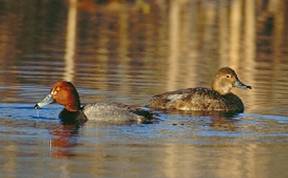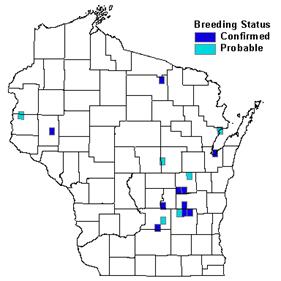Photo by Jack Bartholmai


Status/Protection
- Global Rank: G5 Key to global and state ranks
- State Rank: S2B
- WBCI Priority: SGCN, State Special Concern
Population Information
The Federal BBS information can be obtained at http://www.mbr-pwrc.usgs.gov/bbs/bbs.html by clicking on Trend Estimates and selecting the species in question. All estimates are for time period (1966-2005).
- Federal Breeding Bird Survey: non-significant increase
- Federal Breeding Bird Survey (WI): N/A
- Federal Breeding Bird Survey (BCR 23): N/A
- Federal Breeding Bird Survey (BCR 12): N/A
- Waterfowl Breeding Population and Habitat Survey: increase (1955-2006) (USFWS 2006)
- WSO Checklist Project: inverted u-shaped trend (1983-2007)
Life History
- Breeding Range: British Columbia east to Manitoba to the Great Basin and northern Great Plains states (Woodin and Michot 2002).
- Breeding Habitat: Emergent Marsh, Inland Open Water
- Nest: Floating nest in tall, dense emergent vegetation (Woodin and Michot 2002).
- Nesting Dates: Eggs: early June to early July (Robbins 1991).
- Foraging: Surface dives, dabbles (Ehrlich et al. 1988).
- Migrant Status: Short-distance migrant.
- Habitat use during Migration: Large lakes, reservoirs, and river pools; spring migrants use first open water in shallow marshes and move to deeper wetlands and large lakes as spring thaw proceeds; fall migrants use areas with extensive stands of submerged aquatic vegetation (Wooding and Michot 2002).
- Arrival Dates: Mid-March to late May.
- Departure Dates: Late September to late November.
- Winter Range: Largest concentrations along Laguna Madre of Texas and Tamaulipas, Mexico, Chandeleur Sound off se. Louisiana coast, and offshore of Florida Panhandle in Apalachee Bay; also British Columbia, Washington, n. Idaho, w. Montana, Colorado, n. Texas, e. Kansas, the middle Mississippi and Ohio River Valleys, s. Great Lakes region, and from Atlantic Coast south throughout southern U.S. and most of Mexico (Woodin and Michot 2002).
- Winter Habitat: Habitat specialist in winter - heavily dependent on shallow, coastal ecosystems dominated by seagrass species: shoalgrass, manateegrass, and turtlegrass (Woodin and Michot 2002).
Habitat Selection
Redheads commonly use seasonal and semi-permanent wetlands containing dense stands of cattails, bulrushes, or sedges during the breeding season. Marshes that are most suitable for breeding are characterized by an approximate 50:50 ratio of well-interspersed cover and open water areas (Woodin and Michot 2002). Female Redheads may shift from using primarily small, semi-permanent wetlands during nesting to larger, semi-permanent and seasonal wetlands with more open water for brood rearing (Yerkes 2000). Thus, a mosaic of wetland types may be important. Redheads construct over water nests in relatively tall, dense emergent vegetation (Woodin and Michot 2000). At Horicon Marsh in southeastern Wisconsin – a primary nesting area in the state- nests are built predominantly in cattail stands and occasionally on muskrat houses during high water years (Swanberg 1982, WDNR 2004). Redheads often forage at shallower depths in prairie wetlands, which may provide a richer food source and require less energy expenditure (Torrence and Butler 2006). The diet of adult and juvenile Redheads at Horicon Marsh includes tubers, seeds (Scirpus spp. and Polygonum spp.), Cladocera and Chironomidae larvae, and adult and larval Hemipterans and Dipterans (Kenow and Rusch 1996).
During spring and fall migration, Redheads use large lakes, reservoirs, and shallow river pools such as Lake Onalaska along the Upper Mississippi River near La Crosse, Wisconsin. Small numbers of Redheads are observed wintering on inland lakes and reservoirs, staying as far north as permitted by the abundance of submerged aquatic plants and seeds (Robbins 1991, Woodin and Michot 2002).
Habitat Availability
Horicon National Wildlife Refuge (NWR) in Dodge County provides habitat for the majority of nesting Redheads in Wisconsin (WDNR 1992, Volkert 2006). Several state wildlife areas and at least 16 Waterfowl Production Areas also harbor breeding records (Jahn and Hunt 1964, Robbins 1991) and provide important stopover areas. Redheads are common migrants in the state (Robbins 1991) and frequently use inland lakes, including Rush, Winnebago, Poygan, Winneconne, Buttes des Morts, Koshkonong, Beaver Dam, and Puckaway (Jahn and Hunt 1964, Kahl 1991, WDNR 1992). Fox Lake and Lake Maria also were major fall concentration sites in the mid-twentieth century (J. March, pers. comm.). However, poor water quality at some of these sites may impact their suitability by reducing invertebrate biomass and inhibiting emergent/submergent plant growth (Kahl 1991, WDNR 1992, Kenow and Rusch 1996). Pools 7 and 8 along the Upper Mississippi River and Green Bay and associated marshes also are important feeding and resting areas for migrating Redheads (Fannes 1981, WDNR 1992). A limited number of wintering birds are found each year in Wisconsin, primarily in the southeastern counties (Robbins 1991).
Prior to Euro-American settlement, wetlands occupied an estimated four million hectares of the total fourteen million hectares of Wisconsin’s land area. Today, 53%, or 2.1 million hectares, of these wetland habitats remain (WDNR 1995). Agricultural drainage and urban development remain threats to wetland ecosystems and local populations of wetland-associated birds. Human activities that alter hydrology and introduce invasive plant species also threaten wetland habitats (WDNR 2003). Strict wetland use regulations and incentive programs designed to restore or enhance wetlands, such as Wetland Reserve Program, have helped to curb habitat loss and protect existing wetlands (WDNR 1995). Additionally, the Upper Mississippi River/Great Lakes Region Joint Venture has protected, enhanced, or restored more than 51,000 hectares of upland habitat in Wisconsin as well as 37,000 hectares of wetland habitat.
Population Concerns
Waterfowl Breeding Population and Habitat 2006 survey data indicate that Redheads increased 55% relative to 2005 and 47% relative to the long-term average (1955-2005) (USFWS 2006). Breeding Bird Survey (BBS) data corroborate this trend, suggesting a non-significant annual increase range-wide (Sauer et al. 2005). Redheads are rarely encountered on Wisconsin BBS routes, thus state population trends are not available. Redheads are a fairly common summer resident in eastern Wisconsin according to Robbins (1991); however, breeding was confirmed in less than 1% of the surveyed quads during the Wisconsin Breeding Bird Atlas. The majority of the Atlas confirmations came from Horicon Marsh and Lake Winnebago regions (Volkert 2006).
Although Horicon Marsh attracts a significant number of breeding Redheads, recruitment is poor because of nest predation (WDNR 1992). In Wisconsin, raccoons and mink are responsible for an annual nest predation loss of 18-33%. Female Redheads in Wisconsin have intermediate levels of intraspecific parasitism, but the hatching success of parasitized and non-parasitized nests typically does not differ (Woodin and Michot 2002). Carp and other invasive exotic wetland species are a threat to the health of the aquatic ecosystems that Redheads use for breeding and migration (WDNR 2005). Strict harvest regulations have reduced the annual hunting mortality (Woodin and Michot 2002). Excessive human disturbances, such as recreational boating, can reduce the suitability of staging areas for migrating waterfowl (Korschgen et al. 1985, Kahl 1991). In response to disturbances, the Upper Mississippi River National Wildlife and Fish Refuge recently established more than 17,000 hectares of Closed Areas, which provide waterfowl the opportunity to feed and rest without disturbance during migration and at wintering locations (Kenow et al. 2003, USFWS 2006).
Recommended Management
Because of the apparent low invertebrate biomass available at some wetlands, managing areas for moist-soil plant seeds high in metabolizable energy, such as Leersia oryzoides, may be crucial to supplementing nutrient reserves of breeding females. Invertebrate abundance also may be enhanced through periodic drawdowns of water levels. Water drawdowns also help to control the invasive species impacting wetland systems (WDNR 2005). Management efforts that protect existing wetlands and restore drained wetlands will benefit Redheads and other wetland-associated species. Managers should provide mosaics of seasonal and semi-permanent wetlands located in close proximity. The need for a variety of wetland habitats will require a landscape approach to wetland management (Yerkes 2000). Annual changes in hunting regulations relative to changes in the continental breeding population will continue to be adjusted to achieve appropriate harvest rates.
Research Needs
The long-term effects of wetland enhancement programs on breeding Redheads should be evaluated (Woodin and Michot 2002). More research is needed into methods to restore submergent aquatic beds in large shallow-water lakes (WDNR 2005). Redhead migration ecology and winter ecology need further study. More information is needed on population dynamics, particularly estimates of survival for all stages of the annual cycle. Without these data it is difficult to focus management actions (Woodin and Michot 2002).
Information Sources
- Cornell Lab of Ornithology species account: http://www.birds.cornell.edu/AllAboutBirds/BirdGuide/Redhead.html
- North American Breeding Bird Survey: http://www.mbr-pwrc.usgs.gov/bbs/bbs.htm
- Temple, S.A., J.R. Cary, and R. Rolley. 1997. Wisconsin Birds: A Seasonal and Geographic Guide. Wisconsin Society of Ornithology and Wisconsin Department of Natural Resources, Madison, WI.
- Upper Mississippi River Great Lakes Joint Venture Implementation Plan: http://www.fws.gov/midwest/NAWMP/documents/WaterfowlManagementPlan.pdf
- Waterfowl Population Status report: http://www.fws.gov/migratorybirds/reports/status06/waterfowl%20status%202006.pdf
- Wisconsin Breeding Bird Atlas http://www.uwgb.edu/birds/wbba/
- Wisconsin Department of Natural Resources (WDNR). 1992. Upper Mississippi River and Great Lakes region joint venture – Wisconsin plan. Madison, WI.
References
- Ehrlich, P.R., D.S. Dobkin, and D. Wheye. 1988. The birders handbook: a field guide to the natural history of North American birds. Simon & Schuster, Inc. New York.
- Jahn L.R. and R.A. Hunt. 1964. Duck and coot ecology and management in Wisconsin. Technical Bulletin (33): 1-212. Wisconsin Department of Natural Resources, Madison.
- Kahl, R. 1991. Restoration of canvasback migrational staging habitat in Wisconsin: a research plan with implications for shallow lake management. Technical Bulletin (172): 1-47. Wisconsin Department of Natural Resources, Madison.
- Kenow, K.P. and D.H. Rusch. 1996. Food habits of Redheads at the Horicon Marsh, Wisconsin. J. Field Ornithol. 67(4): 649-659.
- Kenow, K.P., C.E. Korschgen, J.M. Nissen, A. Elfessi, and R. Steinbach. 2003. A voluntary program to curtail boat disturbance to waterfowl during migration. Waterbirds 26(1): 77-87.
- Korschgen, C.E., L.S. George, and W. L. Green. 1985. Disturbance of diving ducks by boaters on a migrational staging area. Wildl. Soc. Bull. (13): 290-296.
- Robbins, S.D., Jr. 1991. Wisconsin birdlife: Population and distribution past and present. Madison, WI: Univ. Wisconsin Press.
- Swanberg, C.D. 1982. Demographic and behavioral characteristics of Redhead ducks nesting in Wisconsin. Master’s thesis, Univ. of Wisconsin, Madison.
- Torrence, S.M and M.G. Butler. 2006. Spatial structure of a diving duck (Aythya, Oxyura) guild: how does habitat structure and competition influence diving duck habitat use within northern prairie wetlands? Canadian Journal of Zoology 84(9): 1358-1367.
- United States Fish and Wildlife Service (USFWS). 2006. Waterfowl population status, 2006. U.S. Department of the Interior, Washington, D.C. U.S.A.
- United States Fish and Wildlife Service (USFWS). 2006. Upper Mississippi River National Wildlife and Fish Refuge Comprehensive Conservation Plan. http://www.fws.gov/midwest/planning/uppermiss/CCP.html. Accessed April 2, 2007.
- Wheeler, W.E., R.C. Gatti, and G.A. Bartelt. 1984. Duck breeding ecology and harvest characteristics on Grand River Marsh wildlife area. Technical Bulletin (145): 1-49. Wisconsin Department of Natural Resources, Madison.
- Volkert, W. 2006. Redhead. In The Wisconsin Breeding Bird Atlas (N.J. Cutright, B.R Harriman, R.W Howe, eds.) The University of Wisconsin Press: Madison, WI.
- Wisconsin Department of Natural Resources (WDNR). 1992. Upper Mississippi River and Great Lakes region joint venture- Wisconsin plan. Madison, WI.
- Wisconsin Department of Natural Resources (WDNR). 1995. Wisconsin’s Biodiversity as a Management Issue. http://dnr.wi.gov/org/land/er/biodiversity/report.htm
- Wisconsin Department of Natural Resources (WDNR) Wetland Management Team. 2003. Reversing the loss: A strategy for protecting and restoring wetlands in Wisconsin. Wisconsin Department of Natural Resources, Madison, WI. http://dnr.wi.gov/org/water/fhp/wetlands/documents/reversing.pdf
- Wisconsin Department of Natural Resources. 2004. Welcome to Horicon Marsh State Wildlife Area. http://www.dnr.state.wi.us/org/land/wildlife/reclands/horicon/ (16 Feb 2005).
- Wisconsin Department of Natural Resources (WDNR). 2005. Wisconsin’s Strategy for Wildlife Species of Greatest Conservation Need. Madison, WI.
- Woodin, M.C., and T.C. Michot. 2002. Redhead (Aythya americana). In The Birds of North America, No. 695 (A. Poole and F. Gill, eds.). The Birds of North America, Inc., Philadelphia, PA.
- Yerkes, T. 2000. Nest-site characteristics and brood-habitat selection of redheads: an association between wetland characteristics and success. Wetlands 20(4): 575-580.
Contact Information
- Compiler: Steven C. Houdek, steve_houdek@usgs.gov
- Editor: Kim Kreitinger, K.Kreitinger@gmail.com
